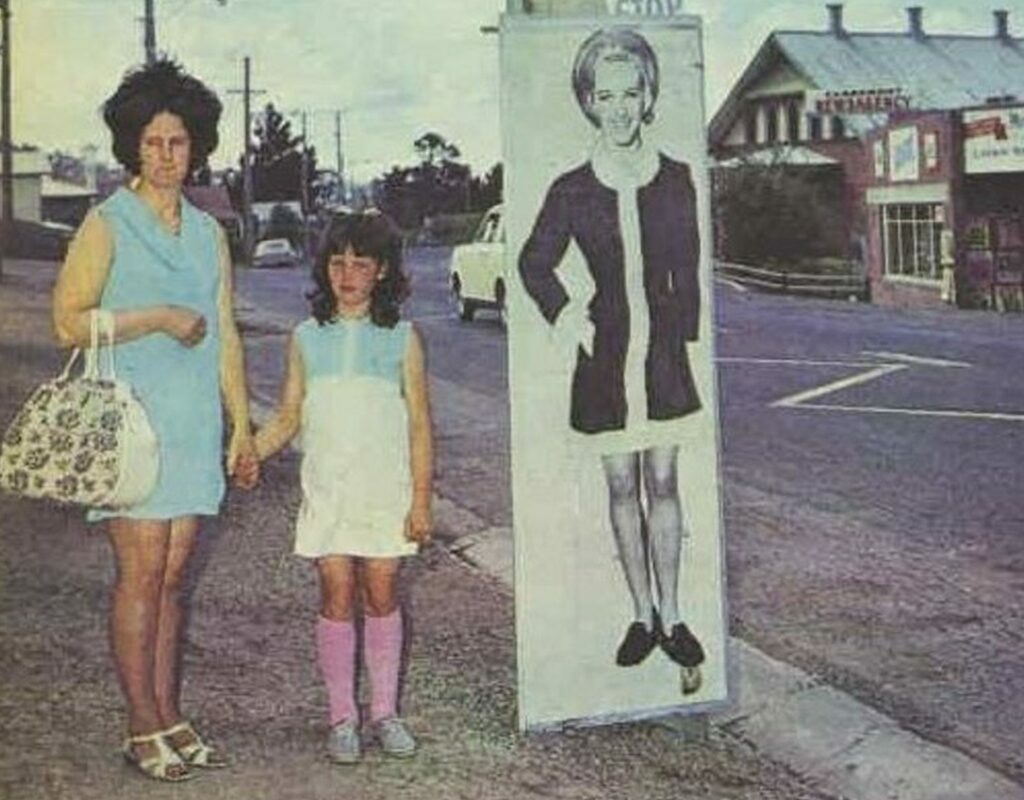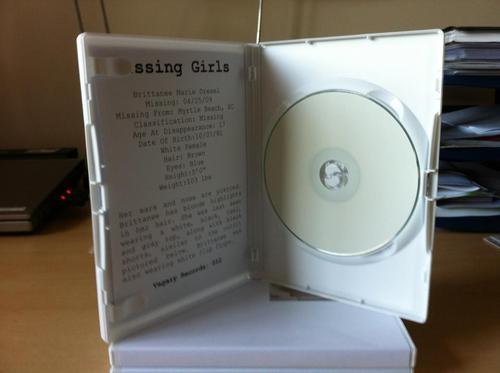Your cart is currently empty!
A Useless Piece of Plastic:
14 Observations Around Missing Girls


I. To be a noise producer (“musician” or “artist” seems less than universally appropriate for practitioners of the discipline; a more neutral term is necessary) is, inherently, to be a pervert. It’s always deviant behavior, always against the grain. But there’s levels to it. Merzbow’s vegan laptop excursions are less perverse than Prurient’s self-consciously edgy punishment marathons, which are less perverse than Torturing Nurse’s live bondage freakout sessions, which are less perverse than Mikko Aspa’s hurtcore jerkoff records, which are no doubt a contributing factor, at this point, to some number of actual crimes against children. It’s easy to sort most noise this way; the work, designed to shock, practically begs you to do it. But there are exceptions. Hijokaidan’s iconic ‘90s run (Modern / Romance / Windom / Noise From Trading Cards) is a good example, a suite of some of the harshest sounds ever recorded, which somehow, nevertheless, feels curiously neutral, unmotivated, like simple natural phenomena. If you look at the album covers from this period, you’ll see nondescript landscapes, casual snapshots, people hanging out, smiling, relaxed – nothing to suggest what’s contained within. It simply exists, undemanding and uncompromising. This is, in its own way, deeply perverse, a disavowal of meaning as such, a submission to raw Event. There are levels to this, and Hijokaidan operates at a deeper one than any of the names mentioned above. On this level, too, there is a certain sort of sorting that can be done – not by perversion (to be at this level is to be beyond the event horizon in that regard), but by teleology, by orientation towards either void or totality. Hijokaidan exists at one end of this range, approaching totality. At the other is a project called Missing Girls.
II. In 1969, a woman is waiting at a bus stop in Claremont, Tasmania. She’s going to spend the night with her fiancé. She’s 20 years old. Blonde hair. A beauty queen contestant. Some sources describe her as a “model,” although 50 years later it’s hard to say what exactly that means. It’s not like she’s anyone famous. She has a lot of plans, but no one would say the course of her life is decided yet. She’s just a woman at a bus stop. About a fortnight ago, one of her friends got an obscene phone call. “I’ve been following you,” the man said. “I watch you through your bedroom window at night.” She reported the call to the police. She had been noticing a man following her in the streets. He was an albino, which made him easy to notice. After he tried to run her off the road, she had taken to wearing a scarf and glasses and a man’s hat, a full disguise, whenever she had to drive that particular stretch. She tells the cops all of this. They don’t take any notes, or ask her to sign a statement. They never follow up. It’s unclear how much the woman at the bus stop knows about all this. They were friends, but not best friends. It’s not the sort of thing you would talk about with just anyone. The bus the woman is waiting for is late. While she’s waiting, a car pulls up at the stop. She recognizes the man inside: it’s the man who lives across the street from her fiancé. He’s an albino, which makes him easy to recognize. He offers her a lift, and she gets in. With this action, she decides the course of her life.
III. In 2009, a man in Sweden named Karl T releases his first album as Missing Girls, and puts this woman’s face on the cover. The album is 90 minutes of fuzzy, arhythmic pops and crackles on a bed of silence. There’s no progression or development. It just makes little noises for a long time and then stops. At the time, no one knows about the albino man. That doesn’t come out until 2015. No one knows he had confessed to killing her in the ‘70s, while being interrogated about the murder of another woman. For this later murder, he would do more than 20 years. For the earlier one, the girl at the bus stop, the cops just didn’t bother following up. This doesn’t come out until even later, only a few years ago now. In 2009, when the tape comes out, all anyone knows is that she was there at the bus stop, and then she wasn’t. This is consistent across the Missing Girls discography. If you look up the names, the cases now, you’ll often find strong leads, plausible suspects, even a conviction or two – none of which, as far as I can tell, was publicly known when Karl made the relevant albums. What this means is the work is not about the crimes as such, because he has no idea what happened. No one does, aside from those who were involved. No: the work is about the absence. About the void. About how she was there at the bus stop, and then she wasn’t.


IV. A tedious aside about genre which will eventually arrive at a point: The first I can remember hearing of “Harsh Noise Wall” as a distinct subgenre of noise was in the early 2010s. Harsh Noise Wall is what it sounds like: a wretched, ceaseless churn of noise. It’s extremely easy to make, only somewhat more difficult to make well, and as such there are hundreds of HNW releases disgorged onto bandcamp and YouTube and archive.org every year now. But it wasn’t like this a decade ago. People were still getting their bearings. You can trace the sound back to the mid-90s, at least, but it’s only around 2010 that it really begins to behave like a “scene” and not a series of freaks semi-independently arriving at the same artistic conclusions. My sense of the history might not be perfectly accurate here, it’s hard to do genealogy on internet scenes more than a few years old, but I think it’s close enough. In any case, the important thing is Missing Girls was not a HNW project. It’s rooted in the same anti-musical static churning, the tracks are similarly long and monotonous, but there’s far too much space, too much silence. What it’s doing will eventually be codified as “Ambient Noise Wall.” There’s a reference to the term preserved in the defunct Tumblr announcement for Missing Girls’ last release, 2012 in an edition of 10, so it’s not as though Karl’s work entirely predates it. But he started doing this in 2009, you’ll remember, four full albums in a single year like a true obsessive, and you won’t find precedent stretching back to the mid-90s – as far as I can tell, his is the first project which really seems to be trying to do what would today be recognized as ANW. The point being: Karl T didn’t start doing this because anyone else was. There was no template to follow, no community to get involved with – besides the nascent HNW one, which in 2012 the same defunct Tumblr still describes him as “divisive” in. The phrase “useless waste of plastic” is mentioned. Connections can be unearthed between Karl and Mack Rabiech Chami, Aleksandar Nenad, Richard Ramirez, probably other “notable” names in the scene – it’s not as if he was a pariah. But sonically speaking he was very much alone out there, at least at the beginning, and it was probably very, very lonely. I’ve listened to some of the releases by other artists on the label he ran, HarshFuckedForLife. They don’t sound like what Missing Girls was doing. Nothing sounded like what Missing Girls was doing.
V. I don’t think there’s a literary equivalent to Missing Girls. I don’t think it’s possible. Words, by their nature, say too much. They can only circle the void, address it, interrogate it, never enter it, embody it, actualize it the way Missing Girls does. Perhaps a text which was nothing but punctuation could approximate it – just the basic marks, the period, the comma, the dash, maybe the colon and semi-colon, although even that might already be too much, and all of it arranged in neat lines, evenly spaced, with no pattern, no design, nothing for the eye to make meaning out of, just a procession of hard stops and soft pauses with no speech to act upon. Or perhaps a text which was just coordinates, latitude and longitude, pointing nowhere in particular with a decimal precision far beyond human usefulness. Perhaps a text which was a single coordinate, and 500,000 characters long. Perhaps. Perhaps.
VI. She was there, and then she wasn’t. It’s worth lingering over this phrase, because if there is a thesis statement for the Missing Girls project, it’s this. It’s important to recognize what’s absent from this formulation: the event. She was there, and then she wasn’t. Two positions, yes and no, positive and negative, 1 and 0 – nothing in-between, no transition, no event. The remarkable thing about this is that noise, usually, lives in that in-between. Noise, usually, is event. There are many, many noise (& power electronics & death industrial & etc.; for my purposes here, “noise” is a catchall term of convenience) albums out there concerning disappeared, murdered women and girls. It’s common enough to be a standard theme, like bondage or genocide. But put on one of them, any of them, and you’ll almost certainly hear something concerned with the event of the disappearing, the murder, the grief, the anger, the thrill, the body living or dead, flesh and terror and, above all else, substance – except Missing Girls. Missing Girls is concerned with the void. It lives in the nothing that follows the event, the space left behind. It lives in the not-there-anymore. Lives on thin broth, as thin as can be imagined, but lives.
VII. In 2009, a girl is having an argument with her boyfriend in Sydney, New South Wales. She’s 15 years old. Of Laotian descent. Last year she moved out of her parents’ house, and in with her boyfriend and his family. She left one night for the high school formal and just never came back. Her parents called the cops, the cops came, they didn’t make her go back. They decided it was a safe environment, which, for once, seems to have been true. Her parents didn’t like that, though, unsurprisingly. She’s on pretty bad terms with them, especially her father. She doesn’t even talk to him anymore. And now, she’s having an argument with her boyfriend, too. It’s late afternoon, after school. They aren’t at home. No one can quite agree on where they are, in retrospect, but it’s in a nearby neighborhood, somewhere between a shopping center and a park a block away. No one can quite agree on the nature of the argument, either. All the details are vague like this. They’re not anything anyone was expecting to be asked about, that anyone thought would be important to remember. Money might have had something to do with it. The girl got a job not too long ago, one shift a week at a local McDonald’s, and she’s saved up a couple hundred dollars. But maybe not. Some sources say it was about their “relationship status,” which could mean anything at all. What can be said with certainty is that an argument happened, and then the boyfriend leaves. Leaves her there alone. The boyfriend will later say she asked him to do it, asked him to leave her alone. Maybe this is a lie. It doesn’t make much difference. What matters is he leaves, and then he never sees her again. Her bank account remains untouched, as does her phone. Over the next few months, following dissemination of her picture by police, there are multiple people call in sightings. Here, there, all around the area. None of these sightings are officially confirmed. Eventually, there’s a Coroner’s Inquest, which finds that she died “on or about” the date of her disappearance. This information isn’t made public until 2019, long after Karl has made a tape about her. In any case, it’s hardly definitive. She might still be alive, somewhere. The men in her life were clearly giving her problems. It would be understandable if she wanted to disappear, wanted to start a new life. She would hardly be the first. But this is could just be wishful thinking. All that can be said for sure is one day she was there at the park, or the shopping center, or somewhere in between, and then she wasn’t anymore.

VIII. Absence is not the same thing as silence. There’s the absence of those who never were – that’s silence. There’s the absence of those who have escaped samsara – that’s silence as well. But the absence of those who have disappeared, who are not-there-anymore – that’s not silence. The not-there-anymore leave too much behind in the world, too many unquiet traces; you stare at their faces in old snapshots, school photos, blurry, blown-up, spat onto newsprint or slathered across some tabloid website, and try to find some secret hidden in the features, some explanation that no one else has found. To your left and your right, a million other people are doing the exact same thing, and you’re all going nowhere, will never get anywhere. But stare long enough, and you can sense it. Something less than a ghost. Something terminally gray, infinitely featureless. A trace, a smear, a faded stain on the fabric of reality. The rupture gushing emptiness like an uncauterized wound. The break in the chain of causality. This is what Missing Girls taps into, what it actualizes in its barely-sound.
IX. In a Missing Girls release, there is no horror; there is no fear; there is no sorrow; there is no joy; there is no anger; there is no thought; there is no voice; there is no speech; there is no expression; there is no light; there is no darkness; there is no present; there is no future; there is no difference between yesterday and ten thousand years ago; there is no ground; there is no sky; there is no heat; there is no cold; there is no air in your lungs, or water, or blood; there is no apocalypse; there is no salvation; most of all, there is no meaning, no meaning whatsoever.
X. I suppose I should mention that I recognize this is all deeply sexually sick. I would hope that’s obvious to everyone, but I guess I should be explicit about it. If no one else is doing something like this, there’s only one reason you would start, obviously. This is true even if you say there’s another reason, even if you believe there’s another reason. Something like this, the motive is always sexual. All noise producers are perverts. But that doesn’t, in itself, make it abjectly indefensible. The average true crime noise project, sure, no question – that’s usually the point. Missing Girls doesn’t sound like the average anything, though. Even other Ambient Noise Wall, usually, does not sound this flat, this plain, this close to the absolute zero of human expression, where life, motion, time becomes impossible. When I read about an unsolved disappearance, where no one knows what happened, where there are no real leads, and try to actually think about it, not come up with a theory of what happened but actually deal directly with the yawning, unspeakable emptiness of it, the not-knowing, the not-there-anymore of it, it feels like how Missing Girls sounds: like something brushing the pickup on an empty turntable, like something rustling against a contact mic, like a hiss of static shutting on and off like a valve. It’s a sound like trying to “see” what you can’t look at, like knowing what you don’t know. I’ve never heard anything else like it, that is actually willing to dive into this unknowingness, this horrible nullity, to live in it and commit to it – and this is why, for all its perversity, Missing Girls is, for me, a more serious, more sensitive treatment of the disappearance than anything a victim’s family would likely be comfortable with. And it’s not comfortable, yes, but it’s true.
XI. In 2009, just two days after the release of the first Missing Girls tape, a girl is walking down the beachfront in Myrtle Beach, South Carolina. She’s 17 years old. From western New York. Her mother doesn’t know she’s there. She didn’t want her to go. She didn’t know the kids she wanted to go with, and she had a premonition that something bad would happen. So they argue. It gets pretty heated. Later, the girl asks if she can go to a friend’s house for a couple days, just to cool down. She’s lying, but her mother believes her, and lets her go. She goes to Myrtle Beach instead, with the kids her mother didn’t know. She’s texting her boyfriend now, who isn’t there with her. He had work. You know how it is. She just walked a mile and a half down the beachfront, from her hotel to the resort another friend is staying at. This friend is 20 years old. He’ll be described in the media as a “nightclub promoter,” which is a fake job. He’ll ultimately appear a number of times on Dr. Phil, verbally sparring with her mother. He’s never seriously suspected of anything, but you can imagine why someone wouldn’t want their teenage daughter around him, just as a matter of principle. The security cameras show her entering the resort, and then show her leaving less than an hour later. It’s late in the evening, or early at night, depending on where you place the boundary. The sun is all the way down. She’s texting her boyfriend, walking down the beachfront at night. Then, at around a quarter past nine, she stops responding to his messages. No one can get ahold of her. Her phone keeps responding to network pings until the early hours of the next morning. Then those stop, too. The last one places the phone 50 miles south of the city, near U.S. Route 17 and the county line. The last text she sent isn’t a matter of public record, but whatever it is, it could be considered her last words. Her boyfriend remembers it, presumably. All anyone else can say is she was walking down the beachfront one night, and then she wasn’t anymore.


XII. I’m looking at the post on the defunct label’s Tumblr again. The one about the last Missing Girls release. It has a couple pictures: off-white CD in white DVD case, cover all white except for the girl’s picture in the corner, the girl walking down the beachfront, looking like a snapshot from someone’s wallet that just fell in the slipcase. It’s impossibly cheap looking, too pathetic to be mistaken for a statement. It just exists. The picture of the case open is more interesting – I can see there’s some liner notes inside. The image is horribly low-res, 2012 camera and 2012 compression – I bend towards the screen and I still can’t really read most of it; typewriter font, center-justified; I can make out “CLASSIFICATION: MISSING”; I can make out “AGE AT DISAPPEARANCE: 17”; I get the idea. It’s strangely exciting: the best documentation of these releases as objects I’ve ever seen, the closest approximation I’ve found to holding one in my own hands, turning it over, looking at it. In the back of my mind is the thought that it’s also the closest I’ll probably ever come. These things were all released in extremely limited quantities over a decade ago, and they likely have minimal resale value. No one is looking for this stuff. It’s entirely possible I’m the only person in the world who would consider paying inflated collector rates for a Missing Girls release (there are none for sale on Discogs, for example, as of this writing). There are two releases I wasn’t even able to track down rips of. I look at the picture a while longer. I think about saving it, then wonder what the point would be. What is there to understand? Nothing. I save it anyway.
XIII. I’m not really sure if Karl T is still alive or not. His name isn’t exactly search engine friendly. It wouldn’t surprise me if he was dead, but I don’t really know, and probably never will. There is an obvious comparison to be made here, not a case of “life imitating art” so much as life simply following the well-worn path towards oblivion. Most people end up barely existing, and then not existing at all. It’s ordinary to disappear.
XIV. If you try to look up Karl T’s label HarshFuckedForLife, where he put out the first Missing Girls release himself, you’ll find a blogspot address and not much else. There may have been a Myspace page associated with the label as well, at some point, but it’s long gone by now. There’s a single post on the blogspot, from 2009, a makeshift shopfront in the familiar bedroom tape label style: “Available” / “Sold Out” / “Soon” headers and a hotmail address for inquiries. In this case, of course, everything is sold out. Nothing is available. Under “Soon” are three lines of text:
NOTHING.
LABEL IS DEAD.
FUCK YOU.
HarshFuckedForLife ceased operations in 2011. Presumably the above was added to the post then, and will remain there until blogspot ceases to exist. In this, at least, there is some vague sense of finality.

